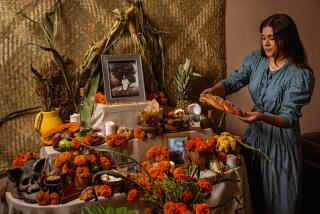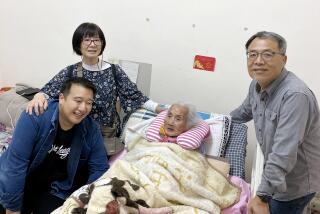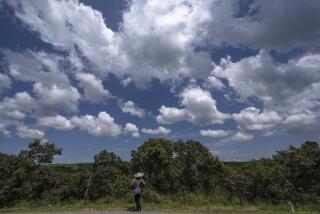Honoring Ancestors and Cultural Roots
- Share via
It’s July, and for followers of East Asian Buddhism like the Rev. Noriaki Ito, that primarily means one thing: It’s time again to honor the ancestors.
Throughout the month, several Buddhist temples plan to memorialize their ancestors with rituals that range from the somber to the festive. The tradition stems from a Buddhist sutra that recounts the story of a disciple who perceived his deceased mother to be suffering in hell. At the Buddha’s advice, the disciple gathered his monastic community to pray for her release.
“Like Mother’s Day, Obon is a reminder of our debt of gratitude to our ancestors,” said Ito, using Japanese Buddhism’s name for the ancestral ceremonies. “In today’s world, we live such busy lives that it takes an event like Obon to make us remember our ancestors and reflect on whether we’re living in ways that would make them happy.”
But the tradition of ancestor veneration common to East Asian cultures comes more from Chinese Confucianism’s teachings on filial piety than Buddhism, Ito said. The two traditions were intermingled in China and spread to Korea, Japan and elsewhere.
Experts say ancestor veneration traditionally served two functions: to preserve the social order by keeping bonds tight across generations and to help ease grief over the loss of loved ones and anxiety about mortality. Although ancestor veneration is strongly identified with Asia, it also is present in other faith traditions.
At the KRST Unity Center of African Spirituality in Los Angeles, for instance, the Rev. Richard Meri Ka Ra Byrd meditates each morning before an altar bearing photos of his congregation’s ancestors.
Before every worship service and meeting, he said, ancestors are honored and symbolically called forth through a ritual pouring of libations. The ritual involves pouring water, a symbol of the infinity of life, on a plant representing Mother Earth to honor ancestors starting from the first -- Ntr, an African word for God -- to the more immediate, Byrd said.
When Byrd introduced the African ancestral rites to his Unity church -- Unity is a Christian denomination -- in 1992, he lost most of the 500 members. “Basically, the whole place emptied out,” he said. “We’ve been so brainwashed that most upper-middle class folks have not wanted to identify with Africa.”
But Byrd says he has slowly rebuilt his congregation, with 100 or so people now attending any given Sunday service, and a roster of 5,000 who claim at least nominal membership.
Ancestor veneration also is a deeply rooted practice among many American Indian tribes.
Before gatherings -- tribal meetings, powwows, sweat lodge ceremonies -- offerings of sage or cedar are presented with prayers to ancestors for blessings, according to Sam English, an Albuquerque artist and a member of the Turtle Mountain Chippewa Indians of North Dakota. Like Byrd, English also offers daily prayers to his ancestors -- rising at dawn and facing east to ask for guidance.
Such rites often were viewed as idolatry by Christian missionaries, many of whom tried to wipe them out where they proselytized.
In China, that issue came to a head in what became known as the Chinese Rites Controversy of the 18th century.
When Jesuit missionaries arrived in China, they found a way to accommodate the Confucian state’s strong ancestral traditions: They compared ancestor veneration to the intercessory prayers Catholics offer to the church’s “communion of saints,” said Father Thomas Rausch, a professor of theological studies at Loyola Marymount University in Los Angeles.
Catholic teachings hold that faithful members of the church who die enter the communion of saints, he said.
In the early 1700s, however, Pope Clement XI condemned those Jesuit efforts. Ancestor worship was prohibited by the church until 1939, when Pope Pius XII rescinded the decision, according to the book “China’s Catholics.”
Today, Chinese American Catholics in parishes such as St. Elizabeth Ann Seton in Rowland Heights hold memorial services for ancestors every Chinese New Year, complete with offerings of flowers, fruit and wine, according to Father Peter Tsang.
Still, the issue is not entirely settled. In places such as Vietnam, the church only recently authorized such popular local practices as ancestral altars and bowing before images of ancestors.
At a 1998 meeting of Asian bishops, a church representative from Vietnam, Etienne Nguyen Nhu The, said the tension between Catholic teachings and ancestor veneration still divided many families and remained the local church’s “most serious pastoral problem.”
Similar tensions have surfaced for Korean Christians, who are overwhelmingly Protestant and therefore do not have such doctrines as the communion of saints to help them accommodate cultural practices.
The Rev. Jim-Bob Park of Young Nak Presbyterian Church in Los Angeles said his congregation has managed to modify rites honoring ancestors to conform to biblical commandments not to worship idols.
In traditional rituals, he said, ancestral spirits would be invited to a table laden with food and offerings, and their descendants would bow before it to pay respects to the spirits. Among Korean Christians, however, memorial services feature a pastor who preaches respect for forebears and calls on Jesus Christ to bless their descendants, Park said.
“We don’t want to kill Korean culture, so we’ve modified it so that the object of worship is God, not an ancestral or evil spirit,” Park said.
Among Buddhists, the various ancestral rites differ according to culture, denomination and even temple.
Japanese Buddhists, for instance, range from those who believe that ancestors actually revisit this world from the spirit realm to people such as Ito, whose Pure Land sect venerates the memory of ancestors but does not believe in spirits.
Most major Japanese Buddhist sects commemorate the Obon season in a similar way: religious memorial services and colorful folk dancing -- a remembrance of the disciple’s dance for joy when his mother was released from the hellish realms, Ito said.
Some Japanese temples also hold cultural performances and a carnival, with food booths and games, as part of their Obon festivities. The Higashi Honganji Temple, for instance, where Ito is minister, will have taiko drumming, karate, a tea ceremony, classical dancing demonstrations and a koto musical performance by jazz artist June Kuramoto at its Obon festival July 26 and 27.
Other temples, such as Nishi Hongwanji on 1st Street, will hold their festivals today and Sunday. At the Hsi Lai Temple in Hacienda Heights, which was established by Buddhists from Taiwan, the first of a monthlong series of ancestral memorials will begin Sunday.
In the first ritual, elaborately dressed Buddhist monastics will be showered with offerings of food and gifts as thanks from the laity for the fervent prayers that liberated the mother of the Buddha’s disciple, according to Cherry Lai of the temple. Then the monastics will begin a five-hour chanting ritual to pray for a better rebirth for the congregation’s ancestors.
In addition to communal festivities, many Buddhists use the season for personal reflection. Ito, for instance, says he reassesses his life and questions whether he is fulfilling the expectations of his late father, Horyu, who preceded him as the temple’s priest.
“The answer that always comes up is: Not really,” Ito said with a wry grin.
More to Read
Sign up for Essential California
The most important California stories and recommendations in your inbox every morning.
You may occasionally receive promotional content from the Los Angeles Times.













